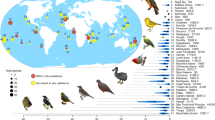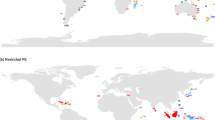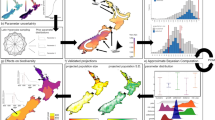Abstract
For centuries, biogeographers have examined the factors that produce patterns of biodiversity across regions. The study of islands has proved particularly fruitful and has led to the theory that geographic area and isolation influence species colonization, extinction and speciation such that larger islands have more species and isolated islands have fewer species (that is, positive species–area and negative species–isolation relationships)1,2,3,4. However, experimental tests of this theory have been limited, owing to the difficulty in experimental manipulation of islands at the scales at which speciation and long-distance colonization are relevant5. Here we have used the human-aided transport of exotic anole lizards among Caribbean islands as such a test at an appropriate scale. In accord with theory, as anole colonizations have increased, islands impoverished in native species have gained the most exotic species, the past influence of speciation on island biogeography has been obscured, and the species–area relationship has strengthened while the species–isolation relationship has weakened. Moreover, anole biogeography increasingly reflects anthropogenic rather than geographic processes. Unlike the island biogeography of the past that was determined by geographic area and isolation, in the Anthropocene—an epoch proposed for the present time interval—island biogeography is dominated by the economic isolation of human populations.
This is a preview of subscription content, access via your institution
Access options
Subscribe to this journal
Receive 51 print issues and online access
$199.00 per year
only $3.90 per issue
Buy this article
- Purchase on Springer Link
- Instant access to full article PDF
Prices may be subject to local taxes which are calculated during checkout



Similar content being viewed by others
References
MacArthur, R. H. & Wilson, E. O. The Theory of Island Biogeography (Princeton Univ. Press, 1967)
Losos, J. B. & Ricklefs, R. E. The Theory of Island Biogeography Revisited (Princeton Univ. Press, 2010)
Lomolino, M. V. A call for a new paradigm of island biogeography. Glob. Ecol. Biogeogr. 9, 1–6 (2000)
Heaney, L. R. Dynamic disequilibrium: a long-term, large-scale perspective on the equilibrium model of island biogeography. Glob. Ecol. Biogeogr. 9, 59–74 (2000)
Schoener, T. W. in The Theory of Island Biogeography Revisited (eds Losos, J. B. & Ricklefs, R. E. ) 53–85 (Princeton Univ. Press, 2011)
Losos, J. B. & Schluter, D. Analysis of an evolutionary species–area relationship. Nature 408, 847–850 (2000)
Kisel, Y. & Barraclough, T. G. Speciation has a spatial scale that depends on levels of gene flow. Am. Nat. 175, 316–334 (2010)
Wagner, C. E., Harmon, L. J. & Seehausen, O. Cichlid species-area relationships are shaped by adaptive radiations that scale with area. Ecol. Lett. 17, 583–592 (2014)
Gillespie, R. G., Claridge, E. M. & Roderick, G. K. Biodiversity dynamics in isolated island communities: interaction between natural and human-mediated processes. Mol. Ecol. Notes 17, 45–57 (2008)
Rosindell, J. & Phillimore, A. B. A unified model of island biogeography sheds light on the zone of radiation. Ecol. Lett. 14, 552–560 (2011)
Wilson, E. O. & Simberloff, D. S. Experimental zoogeography of islands: defaunation and monitoring techniques. Ecology 50, 267–278 (1969)
Whittaker, R. J., Field, R. & Partomihardjo, T. How to go extinct: lessons from the lost plants of Krakatau. J. Biogeogr. 27, 1049–1064 (2000)
Rabosky, D. L. & Glor, R. E. Equilibrium speciation dynamics in a model adaptive radiation of island lizards. Proc. Natl Acad. Sci. USA 107, 22178–22183 (2010)
Schoener, T. W. & Schoener, A. The time to extinction of a colonizing propagule of lizards increases with island area. Nature 302, 332–334 (1983)
Blackburn, T. M., Cassey, P. & Lockwood, J. L. The island biogeography of exotic bird species. Glob. Ecol. Biogeogr. 17, 246–251 (2008)
Sax, D. F. et al. Ecological and evolutionary insights from species invasions. Trends Ecol. Evol. 22, 465–471 (2007)
Kerr, J. T., Kharouba, H. M. & Currie, D. J. The macroecological contribution to global change solutions. Science 316, 1581–1584 (2007)
Sax, D. F. & Gaines, M. S. Species invasions exceed extinctions on islands worldwide: a comparative study of plants and birds. Am. Nat. 160, 766–783 (2002)
Losos, J. B. Lizards in an Evolutionary Tree (Univ. California Press, 2009)
Ojeda Kessler, A. G. Status of the Culebra Island giant anole (Anolis roosevelti). Herpetol. Conserv. Biol. 5, 223–232 (2010)
Helmus, M. R. & Ives, A. R. Phylogenetic diversity-area curves. Ecology 93, S31–S43 (2012)
Poe, S. Comparison of natural and nonnative two-species communities of Anolis lizards. Am. Nat. 184, 132–140 (2014)
Steffen, W., Grinevald, J., Crutzen, P. J. & McNeill, J. The Anthropocene: conceptual and historical perspectives. Phil. Trans. R. Soc. A 369, 842–867 (2011)
Thomas, C. D. The Anthropocene could raise biological diversity. Nature 502, 7 (2013)
Mendenhall, C. D., Karp, D. S., Meyer, C. F. J., Hadly, E. A. & Daily, G. C. Predicting biodiversity change and averting collapse in agricultural landscapes. Nature 509, 213–217 (2014)
Essl, F., Winter, M. & Pysek, P. Biodiversity: trade threat could be even more dire. Nature 487, 39 (2012)
Morinière, V. & Réglain, A. Development of a GIS-based Database for Maritime Traffic in the Wider Caribbean Region (Strategic Plan 10-11, Activity 4.6.b.2., UNEP RAC/REMPEITC-Caribe, 2012)
Bhagwati, J. Protectionism (MIT Press, 1988)
Mahler, D. L., Revell, L. J., Glor, R. E. & Losos, J. B. Ecological opportunity and the rate of morphological evolution in the diversification of greater antillean anoles. Evolution 64, 2731–2745 (2010)
Powell, R. & Henderson, R. W. Island lists of West Indian amphibians and reptiles. Florida Mus. Nat. Hist. Bull. 51, 85–166 (2012)
Pagel, M. Detecting correlated evolution on phylogenies: a general method for the comparative analysis of discrete characters. Proc. R. Soc. Lond. B 255, 37–45 (1994)
Helmus, M. R., Bland, T. J., Williams, C. K. & Ives, A. R. Phylogenetic measures of biodiversity. Am. Nat. 169, E68–E83 (2007)
Acknowledgements
We thank J. Behm, J. Ellers, A. Ives, C. Pfister, J. Vermaat and T. Wootton for critical feedback; S. Buckner, S. Charles, A. Fields, M. López Darias, G. Perry, R. Platenberg, R. Powell, G. Reynolds, A. Sanchez, G. van Buurt and G. Wever for information on anole introductions; and A. Reglain for access to the RAC/REMPEITC-Caribe UNEP shipping traffic data set. M.R.H. was supported by the Netherlands Organisation for Scientific Research (858.14.040) and the US National Science Foundation (DBI 0906011).
Author information
Authors and Affiliations
Contributions
M.R.H. conceived of the study, built the data sets and wrote the manuscript. M.R.H and D.L.M. performed the analyses. J.B.L. was involved in study design and contributed data. All authors discussed the results and commented on the manuscript.
Corresponding author
Ethics declarations
Competing interests
The authors declare no competing financial interests.
Extended data figures and tables
Extended Data Figure 1 Bayesian maximum clade credibility phylogeny of Caribbean Anolis lizards with estimates of geographic history based on native species distributions.
The relative likelihoods of character states at internal nodes31 are depicted as pie charts and are coloured by geography (see tip colours and labels). Grey boxes encompass nodes and edges with relative log likelihood for a mainland state >0.005. Six banks here are identified as having had cladogenetic (in situ) speciation: the Greater Antilles (as previously reported6), St Vincent and Guadeloupe—St Vincent because our phylogeny13,21,29 is different from the phylogeny of the previous work6, and Guadeloupe because unlike the previous work6 we aggregated islands to banks.
Extended Data Figure 2 Caribbean anole bank saturation and the effect of isolation on the species–area relationship (SAR).
a, We used the residuals from a linear regression (dashed line) of the bank SAR and deviations from a 90% quantile regression (dotted line in a–c) of the SAR of islands within the Cuban bank as estimates of native anole saturation (Extended Data Table 2 and 3). SR is species richness. The two metrics of saturation were strongly correlated (ρ = 0.989, P ≪ 0.001). b, Cuban islands span the range of areas exhibited by Caribbean banks and are much less isolated and nearby to Cuba, the most species-rich island in the Caribbean. Our 90% quantile regression is analogous to calculations of island saturation curves based on drawing a line between a source island and a species-rich island very near to the source1. c, In the present day, bank richness has not exceeded the saturation curve, an indication that banks are not currently oversaturated with anoles. Filled symbols indicate banks with exotics. d, Isolation determines much of the nonlinear relationship between past (that is, native) anole richness and area (Fig. 2a) and validates our use of a linear model for the analyses in Tables 1 and 2. The ordinate is the residual from a regression of past species richness on the three isolation metrics, and unlike the raw SAR in a, a linear model (solid line), and not a breakpoint model (Fig. 2a), best fit the data.
Extended Data Figure 3 The loss of the Caribbean anole negative phylogenetic diversity–isolation relationship (PDIR).
a, In the past there was a strong negative PDIR (P = 0.003), but in the present day (b), this negative relationship has been reduced by 71% and c, is no longer significant (see Table 1 footnote for definitions of the values in c). Phylogenetic species variability (PSV) is the mean relative phylogenetic relatedness of all species on a bank32. Red points are banks with, and blue points banks without, in situ speciation. Filled symbols show banks with exotics. Grey points in b are banks that in the past had <2 anole species, but with exotic colonization now have 2 or more species such that PSV can now be calculated32. Note that to be comparable, both the PSV regressions in c are only on the banks with 2 or more native species. Variation in PSV is caused both by colonization and in situ speciation. Specifically, (1) Jamaica, Guadeloupe and St Vincent have low PSV because they are derived from one colonization and then in situ speciation (Extended Data Fig. 1); (2) Grenada, St Eustatius, Anguilla and Antigua have low PSV because each of their two colonizations came from the same clade; (3) Cay Sal, Little Cayman and Acklins have high PSV because they had colonizations from distantly related clades originating from Cuba—each had a natural colonization of the ubiquitous Anolis sagrei and of an ancestor from the carolinensis clade; (4) Great Bahama has high PSV because it received colonizations from both Hispaniola and Cuba; and (5) Cuba, Hispaniola and Puerto Rico have high PSV because they have had much in situ speciation derived from multiple colonizations.
Extended Data Figure 4 The effect of the US trade embargo on Cuban economic isolation.
a, There is a negative economic isolation–area relationship (EIAR) across Caribbean banks. b, The largest residual (studentized) of the EIAR (line in a) is Cuba. c, The predicted economic isolation of Cuba (× symbol) if the trade embargo is lifted, based on the EIAR.
Supplementary information
Supplementary Data
This file contains source data for Table 1. (XLSX 14 kb)
Supplementary Data
This file contains source data for Table 2. (XLSX 15 kb)
Rights and permissions
About this article
Cite this article
Helmus, M., Mahler, D. & Losos, J. Island biogeography of the Anthropocene. Nature 513, 543–546 (2014). https://doi.org/10.1038/nature13739
Received:
Accepted:
Published:
Issue Date:
DOI: https://doi.org/10.1038/nature13739
This article is cited by
-
Local human impacts disrupt depth-dependent zonation of tropical reef fish communities
Nature Ecology & Evolution (2023)
-
Depth zonation of reef fish is predictable but disrupted on contemporary coral reefs
Nature Ecology & Evolution (2023)
-
Island characteristics and species traits predict mammal diversity across islands of the great lakes of North America
Biodiversity and Conservation (2023)
-
Lizards on the borders: source and patterns of colonization of an opportunistic reptile, Podarcis siculus, on the remote island of Pantelleria (Italy) depicted by mtDNA phylogeography and dorsal pattern
Biologia (2023)
-
Original karst tiankeng with underground virgin forest as an inaccessible refugia originated from a degraded surface flora in Yunnan, China
Scientific Reports (2022)
Comments
By submitting a comment you agree to abide by our Terms and Community Guidelines. If you find something abusive or that does not comply with our terms or guidelines please flag it as inappropriate.



